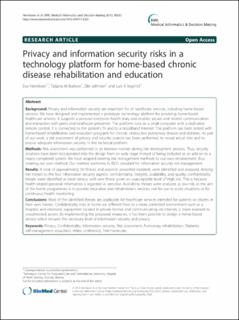| dc.contributor.author | Henriksen, Eva | |
| dc.contributor.author | Burkow, Tatjana | |
| dc.contributor.author | Johnsen, Elin | |
| dc.contributor.author | Vognild, Lars Kristian | |
| dc.date.accessioned | 2023-07-06T07:44:38Z | |
| dc.date.available | 2023-07-06T07:44:38Z | |
| dc.date.created | 2013-08-15T09:50:07Z | |
| dc.date.issued | 2013 | |
| dc.identifier.citation | BMC Medical Informatics and Decision Making. 2013, 13 (85), . | en_US |
| dc.identifier.issn | 1472-6947 | |
| dc.identifier.uri | https://hdl.handle.net/11250/3076455 | |
| dc.description.abstract | Background
Privacy and information security are important for all healthcare services, including home-based services. We have designed and implemented a prototype technology platform for providing home-based healthcare services. It supports a personal electronic health diary and enables secure and reliable communication and interaction with peers and healthcare personnel. The platform runs on a small computer with a dedicated remote control. It is connected to the patient’s TV and to a broadband Internet. The platform has been tested with home-based rehabilitation and education programs for chronic obstructive pulmonary disease and diabetes. As part of our work, a risk assessment of privacy and security aspects has been performed, to reveal actual risks and to ensure adequate information security in this technical platform.
Methods
Risk assessment was performed in an iterative manner during the development process. Thus, security solutions have been incorporated into the design from an early stage instead of being included as an add-on to a nearly completed system. We have adapted existing risk management methods to our own environment, thus creating our own method. Our method conforms to ISO’s standard for information security risk management.
Results
A total of approximately 50 threats and possible unwanted incidents were identified and analysed. Among the threats to the four information security aspects: confidentiality, integrity, availability, and quality; confidentiality threats were identified as most serious, with one threat given an unacceptable level of High risk. This is because health-related personal information is regarded as sensitive. Availability threats were analysed as low risk, as the aim of the home programmes is to provide education and rehabilitation services; not for use in acute situations or for continuous health monitoring.
Conclusions
Most of the identified threats are applicable for healthcare services intended for patients or citizens in their own homes. Confidentiality risks in home are different from in a more controlled environment such as a hospital; and electronic equipment located in private homes and communicating via Internet, is more exposed to unauthorised access. By implementing the proposed measures, it has been possible to design a home-based service which ensures the necessary level of information security and privacy. | en_US |
| dc.language.iso | eng | en_US |
| dc.rights | Navngivelse 4.0 Internasjonal | * |
| dc.rights.uri | http://creativecommons.org/licenses/by/4.0/deed.no | * |
| dc.title | Privacy and information security risks in a technology platform for home-based chronic disease rehabilitation and education | en_US |
| dc.title.alternative | Privacy and information security risks in a technology platform for home-based chronic disease rehabilitation and education | en_US |
| dc.type | Peer reviewed | en_US |
| dc.type | Journal article | en_US |
| dc.rights.holder | © 2013 Henriksen et al.; licensee BioMed Central Ltd. | en_US |
| dc.description.version | publishedVersion | en_US |
| cristin.ispublished | true | |
| cristin.fulltext | original | |
| cristin.qualitycode | 1 | |
| dc.identifier.doi | 10.1186/1472-6947-13-85 | |
| dc.identifier.cristin | 1043298 | |
| dc.source.journal | BMC Medical Informatics and Decision Making | en_US |
| dc.source.volume | 13 | en_US |
| dc.source.issue | 85 | en_US |
| dc.source.pagenumber | 13 | en_US |
| dc.relation.project | Norges forskningsråd: 174934 | en_US |

